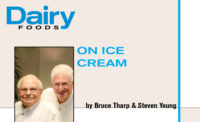Novelties are units of frozen desserts designed for consumption as a single serving. They can be sold individually for immediate consumption or in multiple-serving packages. Novelties are categorized based on the method by which they are produced (molded, extruded, direct filled or pelletized) or by the final form of the product (bars with or without sticks, cones or enrobed pieces).
As such, novelties have their own set of special considerations. The importance of fat agglomeration, freezing-point management, injection of inclusions and delivery of critical sensory characteristics are important to successful novelty formulation, manufacturing, marketing and sales.
Molded novelties are made by adding product (either liquid or frozen/whipped) into a mold, then freezing it within the confines of the mold. A stick is inserted during freezing to facilitate removal of the piece from the mold, to hold it for any surface coating that might be desirable and to use as a handle during consumption.
When filling molds with pre-frozen product such as ice cream, a processor must take care to ensure that no voids exist. For top filling, the ice cream needs to be relatively soft, with low overrun, to completely fill the mold. This has a negative effect on eating quality, profit and shelf life, and limits development of novel products. Such issues, however, can be eliminated by so-called “bottom-up” filling. This involves adding the ice cream from nozzles that descend into the bottom of molds, and then fill them bottom-to-top, as the nozzles are withdrawn. Bottom-up filling allows for the use of ice cream at a lower draw temperature (smaller ice crystals), stiffer viscosities and higher overruns (more profit). It also makes possible more sophisticated products by adding inclusions into the body of the piece versus adding particulates to the surface.
Producing water-ice novelties
A variety of water-ice novelty forms can be made. Layers can be differentiated by filling the mold in stages, with each layer freezing before the next is added. Or, the unfrozen core can be removed via suction before it is frozen, and replaced with a different product to achieve differentiation from the outside to the center or from side to side. Hard frozen pieces can be dipped into a liquid mix after demolding, which produces an outer shell of a different color or flavor.Recently, new approaches to forms and shapes using the so-called Zero Adhesion patented technology have been applied to produce truly novel shapes with very detailed surface features.
Extruded novelties are formed directly from the freezer by discharging stiff product through a nozzle, then cutting the stream to form individual units. A wide range of shapes is possible, ranging in complexity from simple bars to combining multiple streams with different colors/flavors to form complex figures and shapes. Pieces can also be produced so that they can be layered and/or enrobed to form items similar in appearance to a candy bar. Extruded stick novelties can be made by inserting a stick just after extrusion but prior to other processes.
Producing extruded novelties requires achievement of a consistency that is stiff enough for the extruded piece to hold its shape during subsequent handling. Control of stiffness involves achieving very low extrusion temperatures, managing the infrastructure of the frozen product via control of the fat agglomeration, freezing performance and/or the use of a variety of water-immobilization agents.
Production of an extruded novelty with particulate inclusions is complicated because of distortion caused by the interference of the particulates with a smooth cut. This can be overcome by the use of processes that use a high-velocity water to cut the product stream.
Mitigating soggy wafer issues
When an extruded bar is used as a component of an ice cream sandwich, the cookie portion of the piece soon absorbs water from the ice cream and becomes soggy. Coating of the wafer with a water-impermeable edible coating (for example, a chocolate coating) can mitigate the problem.Direct-fill novelties involve filling product directly into various types of single-service cups, push-ups or cones, which can be either filled flat (product level with the top of the cone) or round-topped, sometimes with nuts and/or syrup added. The cones are usually coated internally with chocolate as a moisture barrier to prevent sogginess.
Pelletized ice cream is made by cryogenically freezing (usually in liquid nitrogen) droplets of unwhipped mix (pre-aerated mix may also be possible with limitations). The resulting product, when held at ultra-low temperatures, is free-flowing and sold in single-serve packages. Ultra-low distribution temperatures are necessary when conventional mixes are used to maintain the identity of the individual pellets up to the point of serving. However, by careful control of the freezing point to freeze more water at any given temperature, increased hardness results, which is more compatible with conventional frozen dessert distribution conditions.


